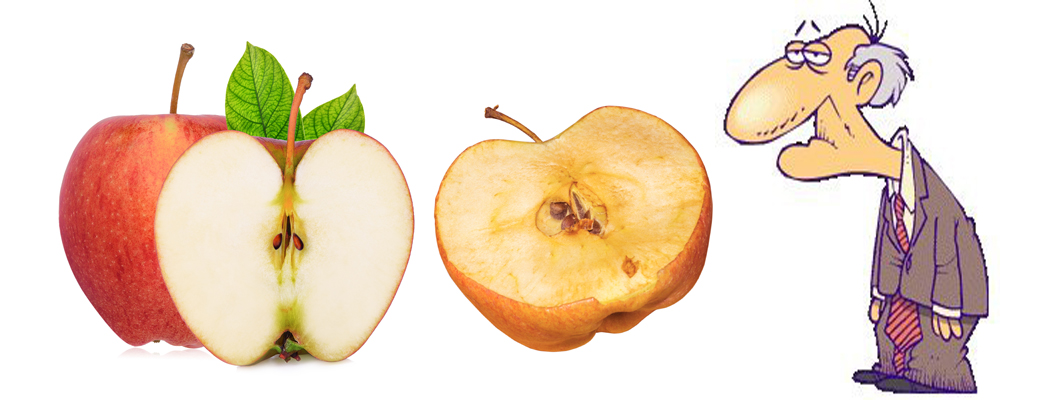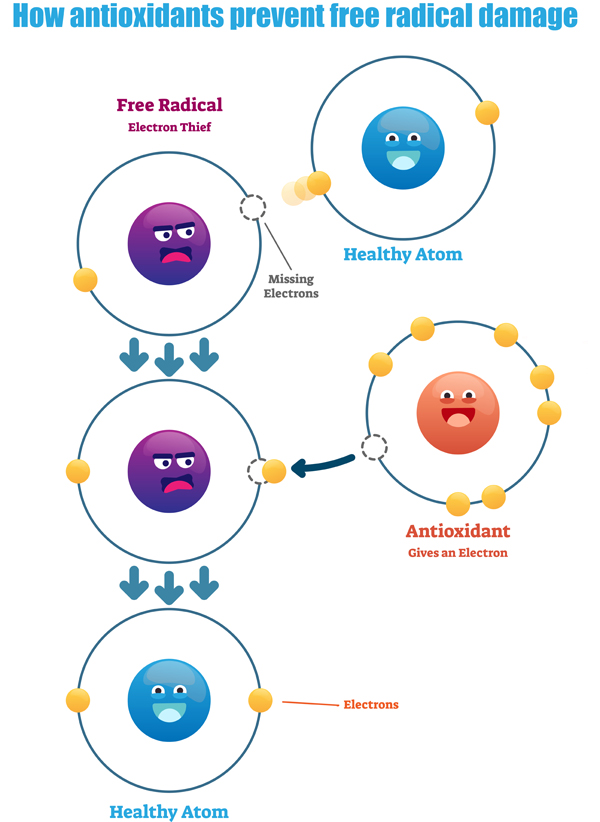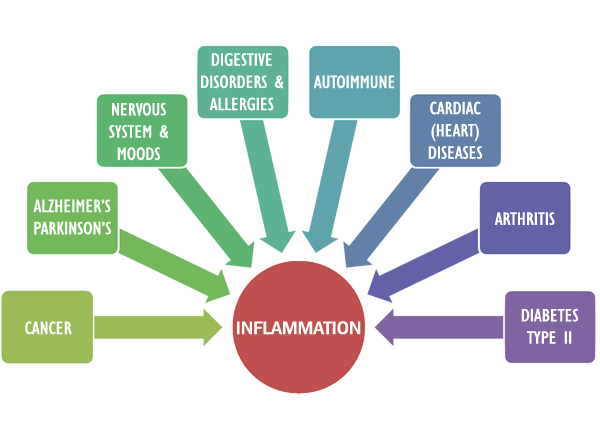“Whatever disturbs to any considerable extent the nutrition of the body, destroys that harmony which exists between the natural waste constantly going on in it and the assimilative processes by which such losses are repaired, and must produce disease.” –Wm Clendenin 1873
That’s right, since 1873 science has known that oxidative stress is an imbalance between free radicals (waste) and the body’s antioxidant repair system. Oxidative stress causes early aging, diseases like Alzheimer’s disease, Parkinson’s, cardiovascular disease and even cancer (Lobo 2012; Matschke 2019).
 Take this freshly cut apple. If it sits on the counter too long, the oxygen in the air turns it brown. It ages. Take the rust on your car bumper or gate. Over time, oxygen in the air reacts with the metal. Is oxygen bad for us? Hahaha… So what is? Only a loss of the systems that prevent aging and rust.
Take this freshly cut apple. If it sits on the counter too long, the oxygen in the air turns it brown. It ages. Take the rust on your car bumper or gate. Over time, oxygen in the air reacts with the metal. Is oxygen bad for us? Hahaha… So what is? Only a loss of the systems that prevent aging and rust.
The oxygen is reacting with the apple molecules to form free radicals. It’s the same chemistry that causes metal to rust. You can prevent the apple from turning brown with lemon juice (an antioxidant). Read on.
What’s a free radical, really?
 Everything, down to the smallest atom, is balanced. Technically, a healthy atom has even numbers of electrons that spin in pairs. For various reasons, in the presence of oxygen and water—the foundations of life—an atom can lose an electron—it goes out of balance—we call this a free radical. If not restored to healthy balance with paired electrons, the free radical can create a ripple effect of more damage, inflammation, and disease that we call oxidative stress
Everything, down to the smallest atom, is balanced. Technically, a healthy atom has even numbers of electrons that spin in pairs. For various reasons, in the presence of oxygen and water—the foundations of life—an atom can lose an electron—it goes out of balance—we call this a free radical. If not restored to healthy balance with paired electrons, the free radical can create a ripple effect of more damage, inflammation, and disease that we call oxidative stress
What fixes this? Antioxidants. Found in many foods, different types of antioxidants can scavenge free radicals; they donate one of their electrons to restore atomic health, and some antioxidants can prevent free radicals from forming in the first place. These nutrients are very special.
Free radicals are as essential to life as breathing. Oxidative stress is not.
It’s all about balance.
Free radicals are used to turn air and food into energy and by certain immune cells to attack and kill foreign invaders.
Purposefully, your immune system depends on free radicals to protect you. Your soldiers, white blood cells called neutrophils and monocytes, recognize foreign bacteria and viruses. When they detect invasion, they use a form of chemical warfare. Literally, these immune cells spray a healthy dose of free radicals (specifically hydrogen peroxide and nitrous oxide) to kill the invaders. There is, however, collateral damage. Some of the surrounding cells are caught in the crossfire (Slauch 2011).
Sentinels of change and stress, another set of immune cells, called macrophages, constantly “eat” foreign invaders, dead or damaged cells, infected cells, and even cancerous cells. Then they “digest” them. Macrophages are the guardians of breathing for your lungs; contribute to your heart’s electrical heartbeat; they help reproductive organs and make reproduction possible (Gordon 2017). Within the macrophages are “trash cans” (technically called phagosomes) with tons of acidic free radicals, (technically called defensins) to attack and disintegrate invaders and defective cells. They also have compounds that bind iron and vitamin B12 which are necessary for invader survival, but also yours.
Purposefully, every cell in your body produces free radicals to make energy. Powerhouses in cells, called mitochondria, use the released electrons to generate energy. Huge supplies of antioxidants neutralize these free radicals. As long as you maintain enough antioxidants, your cells are not harmed. If your antioxidant stores drop too low, then your cells will shut down energy production rather than become injured or die.
Purposefully, your liver removes toxic chemicals and inactivates excess hormones by making free radicals. Then it neutralizes them.
In other words: If your body is tired all the time, you feel depressed or even anxious, perhaps you get sick a lot, your first step should be to evaluate why stressors are boosting your free radicals and why you don’t have enough antioxidants. You’ve gone out of balance.
Feel awful? Fix the oxidative stress
Do these two things:
- Reduce sources of oxidative stress; and
- Provide enough genuine building blocks—by the way, these are NOT necessarily supplements.
Antioxidants and co-factors like Copper, Zinc, Selenium, Magnesium, Glutathione, Vitamin C, Vitamin E, Beta-carotene, omega-3 fats… Get these from real, whole foods. Decide on any additional supplements based on a Nutrition Response Testing exam to see what you need.
What causes oxidative stress?
 Your body needs free radicals. But if it cannot neutralize them, you will not feel well.
Your body needs free radicals. But if it cannot neutralize them, you will not feel well.
While you obviously should minimize exposures to chemicals, environmental pollutants, pesticides, solvents, radiation, electromagnetic fields (EMFs), many medications… because these increase free radicals. Step by step, develop your awareness and do what you can.
Also, give your body genuine building blocks. Do your best to keep your immune system balanced. Chronic inflammation, infection, microbiome imbalances and more will increase your free radical load.
Eating Clean Helps!
Learning how to eat clean and still have variety, greatly reduced my symptoms.
—C.C.
And… repair oxidative stress:
Get these antioxidants and vital nutrients from real, whole, functional foods (Lobo 2010) and follow my links to amazing recipes I’ve made for you at OurNutritionKitchen.com:
Vitamin C: don’t necessarily take a pill—many (most?) are not helpful. Although we cannot make vitamin C and must get it from our diet; broccoli, cauliflower, Brussel sprouts, peppers, kiwi, lemon, and grapefruit are your best sources.
Glutathione: Vitamin C must be regenerated, glutathione does this. Your best sources? High quality, non-denatured, whey protein or home-made bone broth and only from grass-fed animals (Marshall 200).
Melatonin: A hormone naturally found in animal foods and some algae, even crosses the blood-brain barrier to help oxidative stress in the central nervous system.
Tocopherols (vitamin E): These 8 related E vitamins stabilize fats (which are easily oxidized by free radicals), stop the spread of damage, and help recycle other antioxidants like vitamin C.
Uric Acid: Roughly half the antioxidant in blood, you need enough but not too much. Fresh fruits help boost this antioxidant, but fructose sweeteners like corn syrup and agave cause overload (and pain).
Zinc: All seafood, lamb, poultry, sesame & pumpkin seeds, lentils, chickpeas (please soak all beans overnight, before cooking, to make more digestible), certain nuts (cashews, almonds, peanuts—although these can have mold), quinoa (please wash it to remove the gut-irritating coating).
Selenium: Brazil nuts, all seafood (avoid farmed), poultry, beef, lamb, mushrooms (especially crimini and shiitake).
Copper: Clams & oysters, lobster, some nuts & seeds (sesame, sunflower, cashews, pine nuts, hazelnuts), some beans (lentils, chickpeas, lima beans, black beans—please soak all beans overnight, before cooking, to make more digestible), shiitake mushrooms, buckwheat, radishes.
Magnesium: Artichokes, all greens (spinach, swiss chard, beet greens, mustard, turnip…), broccoli, buckwheat (my favorite breakfast), certain seeds (sesame, pumpkin, sunflower—my other favorite breakfast), quinoa (please wash it to remove the gut-irritating coating), some beans (black, navy, pinto—please soak all beans overnight, before cooking, to make more digestible), even tomatoes—which also have many other antoxidants.
Aloe vera, Green tea, Ginger (tea or spice), Turmeric root, Garlic, Onion, Asparagus, Basil, and Cilantro are among my other favorite functional foods to improve the balance between free radicals and health.
Call me at 907-222-1824. Set up your new client appointment.
Let’s Find and Fix What’s Really Wrong.
Clendenin W. (1873). The General Causes of Disease. Public health papers and reports, 1, 46-53.
Gordon, S. & Plüddemann, A. (2017) Tissue macrophages: heterogeneity and functions. BMC Biology, 15, 53
Knight, J.A. (2000) Review: Free radicals, antioxidants, and the immune system. Annals of Clinical & Laboratory Science, 30(2), 145-158.
Lobo, V., Patil, A., Phatak, A., & Chandra, N. (2010). Free radicals, antioxidants and functional foods: Impact on human health. Pharmacognosy reviews, 4(8), 118-26.
Marshall, K. (2004) Therapeutic applications of whey protein. Alternative Medicine Review, 9(2), 136-156.
Matschke, V., Theiss, C., & Matschke J(2019) Oxidative stress: the lowest common denominator of multiple diseases. Neural Regeneration Research, 14(2), 238-241.
Slauch J. M. (2011). How does the oxidative burst of macrophages kill bacteria? Still an open question. Molecular microbiology, 80(3), 580-3.

Leave a Reply
You must be logged in to post a comment.